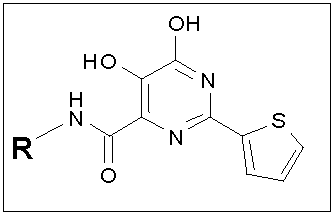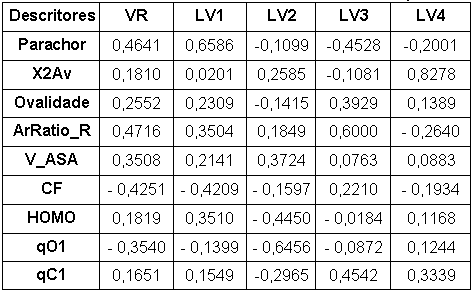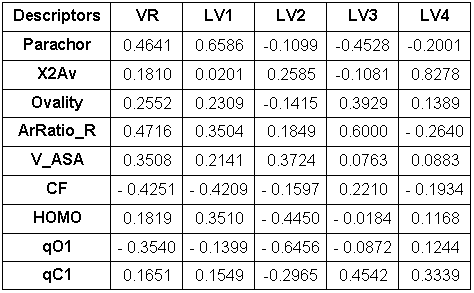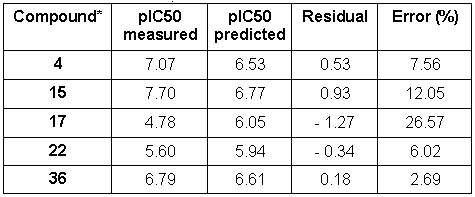
Melo E. B., Ferreira M. M. C., "QSAR MULTIVARIADO DE INHIBIDORES DE HIV-INTEGRASE: CARBOXAMIDAS" ["MULTIVARIATE QSAR OF HIV-INTEGRASE INHIBITORS: CARBOXAMIDES"]. Poços de Caldas, MG, 18-21/11/2007: XIV Simpósio Brasileiro de Química Teórica [14th Brazilian Symposium of Theoretical Chemistry], Resumos [Abstracts], (2007) 13. Poster.
Sociedade Brasileira de Química
(SBQ)
QSAR MULTIVARIADO DE INIBIDORES DE HIV-INTEGRASE: CARBOXAMIDAS
Eduardo Borges de Melo1,2 (PG), Márcia Miguel Castro Ferreira1 (PQ)*
1Inst. De Química/UNICAMP; 2Farmácia/Univ. Est. do Oeste do Paraná (UNIOESTE).*marcia@iqm.unicamp.br
Palavras Chave: HIV, AIDS, integrase, QSAR, PLS.
Introdução
Apesar dos avanços
no tratamento da AIDS, ainda há grande necessidade de novos antiretrovirais
para o combate a infecção pelo HIV. Um dos novos alvos terapêuticos
em estudo é a enzima HIV-integrase, uma das três enzimas virais
essenciais ao ciclo replicativo do HIV1.
O objetivo deste trabalho
foi realizar um estudo QSAR com um conjunto de 33 carboxamidas (Fig. 1)
descritas por Petrocchi et al.2
como inibidoras in vitro da reação de transferência
de fita promovida pela HIV-integrase.
Figura 1. Estrutura básica das carboxamidas. R = grupos aromáticos diversos
Os arquivos de entrada foram
construídos a partir do arquivo DOTRUZ obtido no CSD3
e otimizadas por MM+ no HyperChem 7, seguido de otimização
pelos métodos AM1 e ab initio - HF/6-31G* no GAUSSIAN
03. Dos arquivos de saída foram obtidos descritores eletrônicos
e termodinâmicos.
Parâmetros estéricos,
de solubilidade e topológicos foram obtidos de vários programas,
totalizando 87 variáveis. A seleção foi realizada
pela matriz de correlação e pela Análise Hierárquica
de Agrupamentos, HCA. Para a construção dos modelos foi utilizado
método de Mínimos Quadrados Parciais, PLS, nos dados autoescalados.
Resultados e Discussão
O melhor modelo com 4 variáveis
latentes (LVs), 59,88% de informação total e um outlier
retirado, apresentou SECV de 0,6661, Rcal 0,9055 e Rval 0,7969. As LVs
foram formadas pelos descritores apresentados na Tabela 1.
Para previsão foi
utilizado um conjunto de cinco compostos selecionados dentre aqueles que
apresentaram leverage baixo e resíduo de Student variado.
O erro médio de previsão foi de 10,98% (Rprev 0,9235) o que
foi considerado aceitável para um modelo de QSAR. Os resultados
são detalhados na Tabela 2.
Dentre as variáveis
selecionadas, estão a razão de aromaticidade do substituinte
R (ArRatio_R) destaca-se, pois fortalece a hipótese de uma importante
interação hidrofóbica aromática nesta região4.
A presença da carga parcial do oxigênio (qO1) que, quanto
mais negativa, mais potente o inibidor, fortalece a hipótese5
do mecanismo de ação envolver coordenação com
o cofator metálico Mg+2. A presença
do HOMO (energia do orbital molecular ocupado de maior energia) também
fortalece a hipótese do ataque nucleofílico ao Mg+2.
Também há grande destaque para os descritores estéricos,
indicando que o tamanho/forma dos inibidores influenciam a atividade.
Tabela 1. Descritores
selecionados, vetores de regressão (VR), LV´s e contribuição
especifica de cada descritor em cada LV.

Tabela 2. Resultado
da previsão do modelo.

*numeração
dos compostos é a mesma utilizada na Ref. 2.
Conclusões
Pode-se concluir que os
resultados fortalecem algumas das hipóteses sobre o mecanismo de
ação dos inibidores de HIV-integrase. Porém, os fatores
estéricos também têm grande influência, aumentando
a importância da forma ou flexibilidade do sítio-ativo.
Agradecimentos
FAPESP (M.M.C.F.) e UNIOESTE
(E.B.M.)
____________________________
1 Melo, E. B.
et al. Quím. Nova. 2006, 29, 555.
2 Petrocchi,
A. et al. Bioorg. Med. Chem. Lett. 2007, 17,
350.
3 Arquivo DOTRUZ.
In
Cambridge Structural Database. Versão 5.27 (novembro de 2005) +
1 atualização.
4 Barreca, M.L.
et al. ARKIVOC 2006, 7, 224.
5 Parril, A.
L. et al. In Cundari, T.R. (Ed). Computational Organometallic Chemistry.
2001; New York: Marcel Dekker.
13
English
Sociedade Brasileira de Química
(SBQ)
MULTIVARIATE QSAR OF HIV-INTEGRASE INHIBITORS: CARBOXAMIDES
Eduardo Borges de Melo1,2 (PG), Márcia Miguel Castro Ferreira1 (PQ)*
1Inst. De Química/UNICAMP; 2Farmácia/Univ. Est. do Oeste do Paraná (UNIOESTE).*marcia@iqm.unicamp.br
Key Words: HIV, AIDS, integrase, QSAR, PLS.
Introduction
In spite of advances in
AIDS treetment there is still need for new antiretrovirals to combat HIV
infection. A new therapeutic target is the enzyme HIV integrase, one of
the three viral enzymes responsible for replication cycle of HIV1.
Aim of this work is to make
a QSAR study with a set of 33 carboxamides (Fig. 1), described by Petrocchi
et
al.2 as inhibitors of in vitro
reaction of chain transference by HIV-integrase.
Figure 1. Basic structure of carboxamides. R = diverse aromatic groups
Input files were constructed from file DOTRUZ retrieved from the CSD3 and optimized by MM+ in HyperChem 7, followed by optimization by AM1 andb initio - HF/6-31G* in GAUSSIAN 03. Electronic and thermodynamic descriptors were obtained from output files. Steric descriptors, solubility and topological descriptors were obtained by using various programs, resulting in the total of 87 variables. Variable selection was carried out by using the correlation matrix and Hierarchical Cluster Analysis, HCA. Partial Least Squares PLS was used for autoscaled data to construct regression models.
Results e Discussion
The best model have 4 latent
variables (LVs) containing 59.88% of the total variance, one excluded outlier,
SECV equal to
0.6661, Rcal=0.9055 and
Rval=0.7969. LVs and descriptor contributions are presented in Table 1.
A set of five selected compound with low leverage and moderate Student
residual was used for prediction. Mean error of the prediction was 10.98%
(Rprev=0.9235), considered acceptable for a QSAR model. The prediction
results are in Table 2.
One of the selected variables
is the ration of substituent's R aromaticity (ArRatio_R), supporting the
hypothesis of important hydrophobic aromatic interaction in this region4.
The presence of oxygen partial charge (qO1) also contributes to the hypothesis
according to which the mechanism of action includes oxygen coordination
to the metallic cofactor Mg+2: the more
negative the charge, the potent is the inhibitor. HOMO (energy of the highest
molecular orbital) also points out the hypothesis of the nucleophilic attack
on Mg+2. Contribution of steric descriptors
is also important, indicating that inhibitor's size/shape affect their
activity.
Table 1. Selected
descriptors, regression vectors (VR), LV´s and descriptor contributions
to LVs.

Table 2. Prediction
results for the model.

*numeration for compounds
ins the same as in Ref. 2.
Conclusions
It can be concluded that
the results support some hypotheses about the mechanism of action of HIV-integrase
inhibitors. The influence of steric factors is very important, what points
out the role of form and flexibility of the active site.
Acknowledgements
FAPESP (M.M.C.F.) and UNIOESTE
(E.B.M.)
____________________________
1 Melo, E. B.
et al. Quím. Nova. 2006, 29, 555.
2 Petrocchi,
A. et al. Bioorg. Med. Chem. Lett. 2007, 17,
350.
3 Arquivo DOTRUZ.
In
Cambridge Structural Database. Versão 5.27 (novembro de 2005) +
1 atualização.
4 Barreca, M.L.
et al. ARKIVOC 2006, 7, 224.
5 Parril, A.
L. et al. In Cundari, T.R. (Ed). Computational Organometallic Chemistry.
2001; New York: Marcel Dekker.
13